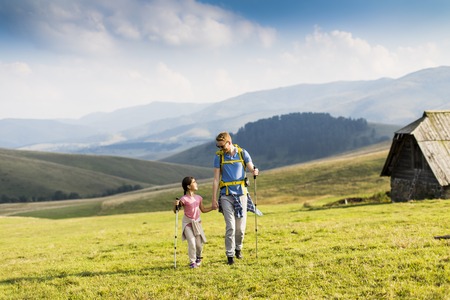Choosing the Right Route
When you’re plotting an accessible walk that’s suitable for families with young children or individuals with disabilities, the route you select can make all the difference between a simple stroll and an epic adventure. The UK is laced with a variety of paths, but not all are created equal—especially when it comes to wheels and little feet. It’s crucial to zero in on trails and parks that are genuinely step-free and barrier-free, where prams glide over smooth surfaces and wheelchairs aren’t challenged by gravel traps or sneaky kerbs. Fortunately, there’s a growing movement across Britain to spotlight these accessible gems. Resources like Accessible Countryside for Everyone, Walks With Wheelchairs, and the National Trust’s own accessibility guides are invaluable when scoping out your next outing. They highlight everything from surface types to toilet facilities, so you know exactly what lies ahead before you lace up your boots or secure those harnesses. By prioritising routes designed for inclusivity—whether that’s a fully surfaced trail in the Lake District or a leafy London park with ramped entrances—you’re setting the stage for a day where everyone can join in, no matter their age or ability. This careful planning transforms an ordinary walk into a true British family adventure—one where nobody is left behind.
Understanding Terrain and Facilities
If you’re gearing up to conquer the British outdoors with little adventurers or family members who have disabilities, it’s vital to scope out the lay of the land. The UK’s wild beauty is legendary, but not all footpaths are created equal. Before lacing up your boots, break down the essentials for a truly accessible walk—so everyone can join in the fun, no matter what the weather throws your way.
The Essentials: What Makes a Walk Accessible?
Accessibility isn’t just about ramps and rails—it’s about creating an experience that brings everyone along for the ride. Here’s a quick breakdown:
| Feature | Why It Matters |
|---|---|
| Smooth Pathways | No one wants to wrestle with gravel or mud if they use wheels or pushchairs—look for tarmacked or well-packed paths. |
| Accessible Loos | Nature calls, rain or shine; check if there are toilets with step-free access and changing facilities en route. |
| Benches & Rest Stops | Frequent benches mean tired legs (big or small) can take a breather without drama. |
| Sheltered Areas | This is Britain—expect rain. Gazebos, covered picnic spots, or even sturdy trees offer refuge from sudden showers. |
Top Tip:
Many local councils and National Trust sites provide detailed maps showing accessible routes and facilities. Always check ahead online—nothing says adventure like being prepared!
Weather-Proofing Your Adventure
The great British weather is famously unpredictable. Sturdy shoes, waterproofs, and spare layers are non-negotiable. But so is knowing where you can duck under cover should the heavens open. Planning your route around these essentials guarantees everyone has a cracking day out—and no one gets left behind when the clouds roll in.

3. Packing the Essentials
Embarking on a British walking adventure with young children or family members with disabilities demands next-level preparation. The UK’s notorious weather can throw everything from blazing sunshine to sideways rain at you within the space of an hour, so your kit needs to be robust, versatile, and tailored for everyone’s needs.
Mobility Aids: Your Ticket to Freedom
If you’re travelling with prams, wheelchairs, or other mobility aids, double-check that they’re fit for the terrain—think puncture-proof tyres and rain covers. Don’t forget spare batteries or portable chargers for powered aids. Consider lightweight ramps or foldable transfer boards for unpredictable access points; British countryside paths are rarely uniform.
Waterproofs: Prepare for Every Downpour
No British excursion is complete without waterproofs. Pack full-length macs, ponchos, and rain covers not just for people but also for mobility equipment and backpacks. Layer up—quick-dry base layers and fleece jumpers are essential in case the temperature drops unexpectedly. Pop a couple of microfibre towels into your bag; they’re compact lifesavers when the heavens open.
Snacks & Hydration: Keeping Spirits High
Walking adventures demand energy. Bring a stash of high-energy snacks—oat bars, fruit pouches, and classic British flapjacks do the trick. For families with sensory considerations or dietary requirements, pre-pack favourite treats to avoid any meltdowns or disappointment. Remember insulated flasks: nothing beats a hot cuppa during a chilly break on a windswept trail.
Sensory Supports: Comfort in the Wild
The unpredictability of new environments can unsettle little ones or those with sensory sensitivities. Pack noise-cancelling headphones, fidget toys, comfort blankets, or weighted lap pads to create a sense of security. Sunglasses and hats help protect against glaring sunlight—rare, but not impossible in the UK!
Adventure-Ready Extras
Don’t overlook practical extras like a small first-aid kit, hand sanitiser (for post-muddy-puddle exploration), wet wipes, and spare socks. A laminated map can be invaluable if tech fails in remote areas where signal is patchy. And finally, always have a charged mobile phone with emergency contacts set up—better safe than sorry in Britain’s wild corners.
4. Transport and Parking Tips
Let’s face it, nothing derails a family adventure quite like arriving at a station only to find it’s all steps and no ramps—or circling endlessly for a Blue Badge bay while the kids grow restless in the back. Here are some practical tips and British know-how to keep your accessible walk on track from the moment you leave your front door.
Public Transport: Plan Like a Pro
Before you set out, check your journey on the National Rail Enquiries or TfL websites for step-free stations and accessible facilities. Most UK train operators now offer detailed accessibility maps, so pinpoint which stops have lifts, ramps, or platform-level boarding. Don’t forget to book ‘Passenger Assist’ if you need extra help—staff can provide ramps or guide you through busy stations.
Step-Free Stations: A Must-Check List
| Station Type | Accessibility Features |
|---|---|
| Mainline (e.g. London Paddington) | Lifts, tactile paving, accessible toilets |
| Suburban/Rural | May have portable ramps, limited lifts |
| London Underground | Select stations only; check TfL’s step-free guide |
Bus and Coach Travel: Don’t Be Caught Out
Buses across the UK are required to be wheelchair accessible, but rural routes can be hit and miss. Check with local operators if you’re heading off the beaten path. For coaches, pre-booking is essential—let them know about buggies or wheelchairs in advance.
Blue Badge Parking: The Lifesaver
If you’re driving, research car parks near your walk’s starting point. Many National Trust and council-run sites offer designated Blue Badge bays close to entrances, often with extra space for ramp access. Use the official Blue Badge parking finder before setting off.
| Car Park Type | Blue Badge Facilities |
|---|---|
| Council-run Car Parks | Marked bays, proximity to amenities |
| National Trust Sites | Reserved spaces near visitor centres |
| Parks & Open Spaces | Variable; check ahead for surfaced paths and dropped kerbs |
The Ultimate Pro Tip:
If you’re venturing somewhere new, ring ahead or drop an email—local rangers or visitor centre staff are often full of insider knowledge about access routes and hidden parking gems. With smart planning, getting there can be as smooth as the walk itself.
5. Planning Rest Stops and Breaks
When you’re plotting your accessible walk across the rolling hills or leafy parks of the UK, don’t just think about the start and finish – it’s all about the journey, and that means structuring your route to include regular opportunities for everyone to pause, recharge, and soak up those marvellous British vistas. Whether you’re wrangling a buggy, navigating with a wheelchair, or keeping little legs motivated, well-timed pit-stops can make all the difference between adventure and ordeal.
Scheduling Regular Pit-Stops
No one likes to feel rushed or worn out before they’ve even reached the halfway point. Aim to map out rest breaks every 20-30 minutes – especially if you’ve got young children or anyone who may need extra time to catch their breath. Look for benches along paved paths, sheltered spots under ancient oaks, or even café terraces in local nature reserves where a hot cuppa is never far away.
Inclusive Play Areas
Many British parks and walking trails now feature accessible play areas designed for all ages and abilities. These are not just a godsend for restless youngsters needing to burn off energy, but also offer sensory activities and inclusive equipment so nobody feels left out. Check council websites or community boards for details before you set off – nothing beats seeing beaming faces as everyone clambers, swings, and explores together.
Perfect Picnic Spots
Packing a picnic is practically a rite of passage on a UK family walk. Scout out level grassy patches or tables with wheelchair access – bonus points if there’s a view of grazing sheep or a babbling brook nearby. Don’t forget classic British treats: sausage rolls, crisps, and perhaps a flask of tea. Allow plenty of time to linger; sometimes the best memories are made when the boots come off and the jam sandwiches come out.
A Chance to Take It All In
Ultimately, these planned pauses aren’t just about rest – they’re opportunities to savour your surroundings and share stories with your crew. Encourage everyone to spot birds overhead, listen for rustling leaves, or simply bask in the fresh air. By weaving in these thoughtful breaks, you’ll transform your accessible walk from a challenge into an unforgettable family adventure across Britain’s great outdoors.
6. Preparing for the Unexpected
Let’s face it: no matter how meticulously you plan your accessible walk, Britain’s wild spirit has a habit of throwing in a surprise or two. Whether it’s a sudden downpour, an impromptu path diversion due to sheep on the loose, or an unexpected muddy patch right where you least need it, staying flexible is the true mark of an intrepid family adventurer.
Weathering the Storms – Literally
Packing for all seasons isn’t just a cliché in the UK—it’s standard practice. Keep lightweight waterproofs handy, stash some spare socks and perhaps even a compact brolly in your kit. The secret to keeping little ones cheerful when rain clouds gather? Turn puddle-jumping into part of the fun, and remember that wet weather often means you’ll have tranquil paths all to yourselves.
Navigating Path Diversions with a Smile
Footpaths can sometimes be rerouted at short notice—construction, local events, or conservation work are common culprits. Before setting out, check local council websites or community notice boards for updates. If you do hit an unexpected diversion, treat it as an opportunity to discover a new corner of the countryside. Bring along a map or download a reliable walking app so that you can adapt your route on the fly without any fuss.
Staying Positive and Resourceful
When things veer off course, your attitude makes all the difference. Turn challenges into stories for later—after all, every explorer faces a little adversity! Pack extra snacks and small games to keep spirits high during delays. If mobility equipment faces terrain difficulties, don’t hesitate to ask fellow walkers for help; British ramblers are famously friendly and always up for lending a hand. By embracing the unknown with humour and grit, your family will return home not just with tired legs but with hearts full of adventure.

